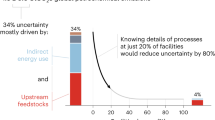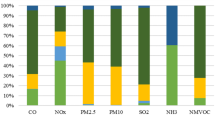Abstract
Purpose
In order to understand the environmental outcomes associated with the life cycle of a product, to compare these outcomes across products, or to design more sustainable supply chains, it is often desirable to estimate results for a reference supply chain representative of the conditions for a sector in a specific region. This paper, by examining ethanol and gasoline production processes, explains how choices made in the calculation of sector-representative emission factors can have a significant effect on the emission estimates used in life cycle assessments.
Methods
This study estimates reference emission factors for United States dry-grind corn ethanol production and gasoline production processes suitable for use in baseline life cycle assessment unit processes. Based on facility-specific emissions and activity rates from the United States National Emissions Inventory, the Energy Information Administration, and an ethanol industry trade publication, the average emissions per unit energy content of fuel are computed using three different approaches. The Tool for the Reduction and Assessment of Chemical and Other Environmental Impacts (TRACI) characterization factors are used to estimate impact potentials for six environmental and three human health categories. Sector-specific direct emissions and impact potentials are compared across the three approaches and between the two sectors. The system boundary for this analysis is limited to the fuel production stage of these transportation fuel lifecycles.
Results and discussion
Findings from this work suggest that average emission factors based on total emissions and total production may significantly under estimate actual process emissions due to reporting thresholds and otherwise unreported emissions.
Conclusions
Because of the potential for unreported emissions in regional inventories, it is more appropriate to estimate sector reference emission factors based on matched sets of facility or process level emissions and activity rates than to use aggregated totals. This study demonstrates a method which can be used for inventory development in cases where multiple facilities producing the same product are involved.



Similar content being viewed by others
References
Bare JC (2002) TRACI: the tool for the reduction and assessment of chemical and other environmental impacts. J Ind Ecol 6:49–78
Bare JC (2013) Tool for the Reduction and Assessment of Chemical and other Environmental Impacts (TRACI). http://www.epa.gov/nrmrl/std/traci/traci.html. Accessed 2 July 2013
Bennear LS (2008) What do we really know? The effect of reporting thresholds on inferences using environmental right-to-know data. Regul Gov 2:293–315
Curran MA (2012) Sourcing life cycle inventory data. In: Curran MA (ed) Life cycle assessment handbook: a guide for environmentally sustainable products. Wiley, Hoboken, pp 105–141
de Haan M, Keuning S (1996) Taking the environment into account: the NAMEA approach. Rev Income Wealth 42:131–148
Environmental Integrity Project (2004) Gaming the system how off-the-books industrial upset emissions cheat the public out of clean air. http://www.environmentalintegrity.org/pdf/publications/eip_upsets_report_appendixa.pdf. Accessed 2 July 2013
EPM (2011) USA Plants. http://www.ethanolproducer.com/plants/listplants/USA/. Accessed 2 July 2013
Hagelaar G, van der Vorst J (2001) Environmental supply chain management: using life cycle assessment to structure supply chains. Int Food Agribus Man 4:399–412
Hawkins T, Ingwersen W, Srocka M, Transue T, Paulsen H, Ciroth A (2013) Development of tools to promote efficient life cycle assessment: OpenLCA and the LCA harmonization tool. Paper presented at the ICOSSE ‘13 - 3rd International Congress on Sustainability Science & Engineering, Cincinnati, OH
Hendrickson C, Horvath A, Joshi S, Lave L (1998) Economic input–output models for environmental life-cycle assessment. Environ Sci Technol 32:184A–191A
Ingwersen W et al. (2013) LCA models at the core of the sustainable supply chain toolkit: a paper towel case study. Paper presented at the ISSST Conference, Cincinnati, OH, 16th May 2013
Kim J, Yang Y, Bae J, Suh S (2013) The importance of normalization references in interpreting life cycle assessment results. J Ind Ecol 17:385–395
Kwiatkowski J, McAloon A, Taylor F, Johnston D (2006) Modeling the process and costs of fuel ethanol production by the corn dry-grind process. Ind Crop Prod 23:288–296
Lenzen M, Moran D, Kanemoto K, Geschke A (2013) Building EORA: a global multi-region input–output database at high country and sector resolution. Econ Syst Res 25:20–49
Lombardi K, Fuller A (2013) ‘Upset’ emissions: flares in the air, worry on the ground. http://www.publicintegrity.org/2013/05/21/12654/upset-emissions-flares-air-worry-ground. Accessed 2 July 2013
Mazzanti M, Montini A (2010) Embedding the drivers of emission efficiency at regional level — Analyses of NAMEA data. Ecol Econ 69:2457–2467
Miranda ML, Keating MH, Edwards SE (2008) Environmental justice implications of reduced reporting requirements of the toxics release inventory burden reduction rule. Environ Sci Technol 42:5407–5414
Mueller S (2010) 2008 National dry mill corn ethanol survey. Biotechnol Lett 32:1261–1264
Nwe E, Adhitya A, Halim I, Srinivasan R (2010) Green supply chain design and operation by integrating LCA and dynamic simulation. In: Pierucci S, Ferraris GB (eds) Computer aided chemical engineering, vol 28. Elsevier, pp 109–114
Suh S (2005) Developing a sectoral environmental database for input–output analysis: the comprehensive environmental data archive of the US. Econ Syst Res 17:449–469
Tukker A et al (2013) EXIOPOL – Development and illustrative analyses of a detailed global MR EE SUT/IOT. Econ Syst Res 25:50–70
U.S. EIA (2011) Petroleum & other liquids. http://www.eia.gov/petroleum/data.cfm. Accessed 1 March 2011
U.S. EPA (1998) Air pollution operating permit program update key features and benefits. United States Environmental Protection Agency, OAQPS, Research Triangle Park
U.S. EPA (2007) Prevention of significant deterioration, nonattainment new source review, and Title V: treatment of certain ethanol production facilities under the “Major Emitting Facility” definition; final rule vol 72. Federal Register
U.S. EPA (2013a) Emissions factors & AP 42, compilation of air pollutant emission factors http://www.epa.gov/ttn/chief/ap42/index.html. Accessed 2 July 2013
U.S. EPA (2013b) Air trends. http://www.epa.gov/airtrends/sixpoll.html. Accessed 2 July 2013
U.S. EPA (2013c) National Emissions Inventory (NEI) Air pollutant emissions trends data. http://www.epa.gov/ttnchie1/trends/. Accessed 2 July 2013
U.S. EPA (2013d) Laws and regulations. http://www.epa.gov/emergencies/lawsregs.htm. Accessed 2 July 2013
U.S. EPA (2013e) Toxics Release Inventory (TRI) Program. http://www.epa.gov/tri/. Accessed 2 July 2013
U.S. EPA (2013f) 2008 national emissions inventory, version 3 technical support document. U.S. Environmental Protection Agency, Office of Air Quality Planning and Standards. http://www.epa.gov/ttn/chief/net/2008neiv3/2008_neiv3_tsd_draft.pdf
You F, Tao L, Graziano D, Snyder S (2012) Optimal design of sustainable cellulosic biofuel supply chains: multiobjective optimization coupled with life cycle assessment and input–output analysis. AIChE J 58:1157–1180
Young DM, Hawkins T, Ingwersen W, Lee S-J, Ruiz-Mercado G, Sengupta D, Smith RL (2012) Designing sustainable supply chains. Chem Eng Trans 29:253–258
Acknowledgments
The work presented here was funded by the EPA Office of Research and Development. This project was supported in part by an appointment to the Research Participation Program at the Office of Research and Development, National Risk Management Research Laboratory, United States Environmental Protection Agency, administered by the Oak Ridge Institute for Science and Education through an interagency agreement between the United States Department of Energy and EPA.
Disclaimer
The views expressed in this article are those of the authors and do not necessarily reflect the views or policies of the U.S. Environmental Protection Agency.
Author information
Authors and Affiliations
Corresponding author
Additional information
Responsible editor: Seungdo Kim
Electronic supplementary material
Below is the link to the electronic supplementary material.
ESM 1
(XLSX 591 kb)
Rights and permissions
About this article
Cite this article
Sengupta, D., Hawkins, T.R. & Smith, R.L. Using national inventories for estimating environmental impacts of products from industrial sectors: a case study of ethanol and gasoline. Int J Life Cycle Assess 20, 597–607 (2015). https://doi.org/10.1007/s11367-015-0859-x
Received:
Accepted:
Published:
Issue Date:
DOI: https://doi.org/10.1007/s11367-015-0859-x




